

Plants And Animals. EnergyPlants And Animals The Brief Overview NASA satellites keep an eye on Earth’s water and air—which are essential for life on Earth.
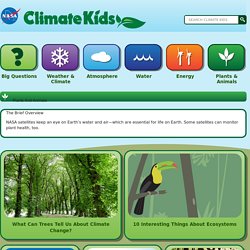
Some satellites can monitor plant health, too. Wet and wild 2018 is officially fourth-hottest year. Overall, 2018 was the fourth-warmest year on record.
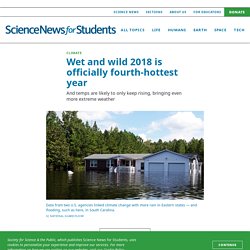
Only the three preceding years have been hotter. And these global records will likely be broken soon. Climate change trends suggest Earth’s fever will continue to climb, scientists reported on February 6. They spoke at a joint news conference by the National Oceanic and Atmospheric Administration and NASA. The agencies collected data on global temperatures throughout 2018. What the world will look like 4°C warmer. Wet and wild 2018 is officially fourth-hottest year. National Geographic.
(4) What Happens When Cape Town Runs Out of Water? (4) Extreme Weather 101: Drought. (4) Causes and Effects of Climate Change. Climate change will make America much warmer by 2050. See how these US cities will change. Our world is getting warmer.
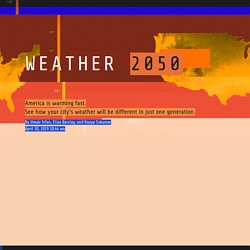
This we know. Just look at Los Angeles, which experienced all-time record heat in July, topping out at 118 degrees Fahrenheit. Dozens of other heat records across the United States were smashed last summer alone. Climate-friendly farming is taking root in New York. Didi Barrett, a New York state assemblymember, has visited Stone House Grain, a farm in the Hudson Valley, enough times to be a seasoned tour guide.
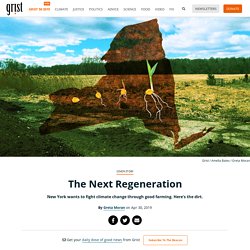
That’s what it felt like, at least, as we drove in a Jeep down a narrow road, through fields blanketed by cover crops and perennial pastures spread out like a gold-and-brown checkerboard. It was mid-March, a time of dormancy for most plants in the region. Poplar trees, bare of any leaves, lined either side of the road. But the farm was already teeming with life. From behind the wheel, Ben Dobson, the farm manager, explained why his farm was unseasonably busy. It’s all part of a natural cycle: On warm days, Dobson’s crops pull carbon dioxide from the sky and release it into the soil where it nourishes developing plants. Dobson’s work drew the attention of Barrett a few years back. At one point, we stop the car to look out over rows of the dried, golden-brown remains of a soybean crop. But humans need farms to survive. #1 What is "global climate change"? The Short Answer: Climate change describes a change in the average conditions — such as temperature and rainfall — in a region over a long period of time.
NASA scientists have observed Earth’s surface is warming, and many of the warmest years on record have happened in the past 20 years. Weather vs. #2 How Farmers Adapt to Climate Change. For the Instructor These student materials complement the Future of Food Instructor Materials.
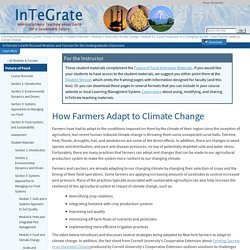
If you would like your students to have access to the student materials, we suggest you either point them at the Student Version which omits the framing pages with information designed for faculty (and this box). Or you can download these pages in several formats that you can include in your course website or local Learning Managment System. #3 Ways Farmers Can Combat Climate Change. This article is contributed in support of The Rainforest Alliance.
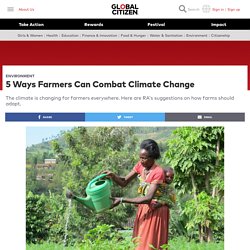
Climate change is turning the lives of farmers upside-down, and is fundamentally changing the way agriculture is practiced. Drastically different weather patterns, shorter growing seasons, extreme weather, and many other changes pose daunting problems for smallholder farmers around the world—especially in the tropics. Foods that we consume daily—coffee, bananas, and cocoa come to mind—hail from these tropical regions, and in many cases, are mostly grown by smallholder farmers whose livelihoods depend on regular weather and consistent crop yields. These farmers are on the front lines of climate change, with little access to resources to help cushion the disruptions climate change can cause in their operations and within their daily lives.
Since these farmers are often the most vulnerable to the effects of climate change, working with them to build “climate resilience” is critically important for global food security. 1. #4 How will climate change affect agriculture? #5 UN report shows climate change effect on farming. #6 Climate Impacts on Agriculture and Food Supply. On This Page: Overview Agriculture is an important sector of the U.S. economy.

The crops, livestock, and seafood produced in the United States contribute more than $300 billion to the economy each year.[1] When food-service and other agriculture-related industries are included, the agricultural and food sectors contribute more than $750 billion to the gross domestic product.[2] #7 PDF VERSION a clever fix to the biggest climate problem. #7 A Clever Fix to the Biggest Climate Problem – Nexus Media. By Jeremy Deaton Climate change is a big, unwieldy problem with no easy fix.
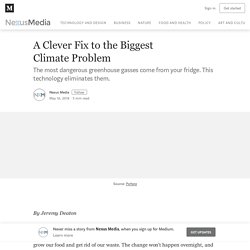
To stem the rise in temperature, we need to transform how we power our homes, fuel our cars, grow our food and get rid of our waste. Transportation, Air Pollution, and Climate Change. On this page: Transportation and Climate Change Burning fossil fuels like gasoline and diesel releases carbon dioxide, a greenhouse gas, into the atmosphere.
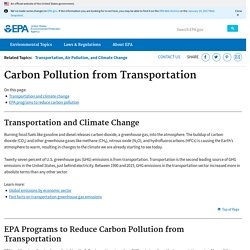
The buildup of carbon dioxide (CO2) and other greenhouse gases like methane (CH4), nitrous oxide (N2O), and hydrofluorocarbons (HFCs) is causing the Earth’s atmosphere to warm, resulting in changes to the climate we are already starting to see today. Twenty-seven percent of U.S. greenhouse gas (GHG) emissions is from transportation. Transportation is the second leading source of GHG emissions in the United States, just behind electricity.
#9 How US Corn Farmers Adapted to Climate Change. Changing weather and planting practices in recent decades have led to increased corn yields, but whether the findings will apply to other crops and regions remains unknown.

(23) Hot Mess.